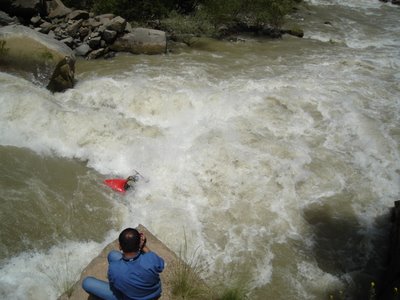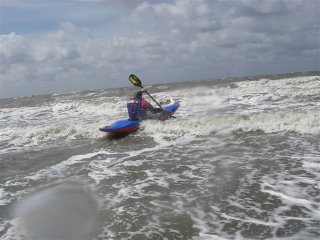
The first week of june Dave Manby organised his 2nd annual Extreme event on the Coruh-river in the north-eastern part of Turkey. The event started in Ispir and finished in Yusufeli, 110 km downstream. A mass-start, an individual down-river-race and a slalom on the Bahal-river were on the program, with participants from the USA, England, Iran and Belgium.
The event was won by Belgian Pro-team paddler Steven Van den heuvel (paddling the new-
XENO), ahead of Amir Hussein from Iran. The event was the perfect way to explore the Coruh-river! Thank you Dave!!!
 Steven Van den heuvel enjoys
Steven Van den heuvel enjoyscheck:
www.coruhextreme.comTHE ÇORUH RIVER (written by Dave Manby)
Section: Bayburt to Artvin
Difficulty: V+ in high water
Season: May to August.
Length: Bayburt - Ispir 100 km class II
Ispir - Yusufeli 110 km class V
Yusufeli - Artvin 70 km class V
Character: Remote, though not a wilderness trip as a road runs along side for most of its length.
Turkey prides itself as where East meets West. It is where Asia and the Middle East meet Europe. Turkey's capital, Istanbul, straddles the Bosporus and can genuinely claim to be one city in two continents. Turkey's history goes back to prerecorded time. Mesopotamia, (translated means: the land between two rivers!) was between the Tigris and the Euphrates (or the Dicle and Firat Nehri in Turkish) which rise in Eastern Turkey. History and the armies of Alexander the Great, of Islam and the Crusades have all swept through this land. Marco Polo when he was exploring the "Silk Road" traveled through Turkey passing by Erzurum and Mount Ararat and then north through Bayburt to the Black Sea on his return journey.
The North East corner is a rugged and inaccessible area. Alexander the Great by-passed the region, the Roman Empire only ruled it as a vassal state for three years. Smaller empires of the Armenians, Bagratians, and Georgians controlled the valuable trade route through the valleys at different times. Bayburt, one of the put-ins for trips down the Çoruh boasts the largest fortress in Turkey. This 6th century castle now sits on the hill above the modern town and bears witness to a bygone age when Bayburt was a major center of commerce. From Bayburt to Ispir the river is flat, only aspiring to class II-III as it nears Ispir. The river however is more remote with no road intruding till Maden, some 20kms upstream of Ispir. It is during this stretch that the river swings through 180 degrees and flows along the Kackar mountains looking for a weakness to break trough and escape to the Black sea.
Though Bayburt is sometimes used as the put-in most trips, hungry for the rapids, start a short way upstream of the little village of Ispir. From the old castle above Ispir, now converted into a mosque, it is possible to gain a glimpse of the river as it enters a narrow gorge full of white water. Though the gorge opens out after some ten kilometers the white water remains.
Many of the rapids on the Çoruh have been named, but because of their frequency and the fact that they have been named by independent groups much time can be spent working out whether a particular rapid is "Minister's rapid" and if so is it the same rapid as "The Stud". In 1991 the Minister of Tourism joined a white water festival rafting down the river and took a lengthy swim at the rapid that now bears his name. This rapid also happens to form one of the "Joan Collins Set", which are the first five major rapids that arrive within 15kms. of Ispir; "Joan", dark and mysterious is followed by "Alexis", pleasant but can turn nasty.
"The Bitch" is self explanatory and is followed by "Dynasty" (sometimes spelt by a dyslexic as dysentery) and finally "The Stud". At high water these are an awesome set of rapids almost merging into each other and will leave even the world-weary expert impressed.
After this opening assault , the river eases and at normal rates of river running it still provides one or two major rapids and an almost endless stream of class III rapids each day till Yusufeli is reached. Along this stretch castles are easily seen perched on the rocks above the river and others can be spotted if you know where to look. These make great off-river excursions though the castle at Tekkale (Single Castle) needs a little local knowledge and stout nerves to climb the loose rock to reach it. A simpler and safer plan is to take a taxi to Dortkilesi (Four Churches) and explore the ancient and unexpectedly large 10th century Armenian church. Irrigation canals pinch water off the river at regular intervals and can be seen contouring the river banks for several kilometers before delivering the water to the fields. "Perfect Portage" uses one of these as an easy kayak sneak if the paddler wants to avoid the rapid. Rice and their paddy fields are spreading upstream and these are taking over from the wheat fields. Fruit orchards, with cherries, mulberries, apples, peaches and other fruits are also grown along the river. Olive groves are found when the ground is level but the water scarce.
The Bahal river, which is a pleasant class III for both rafts and kayaks from Sarigol down and a class V kayak (only) run upstream of Sarigol, joins the Çoruh at Yusufeli. Even if you decide not to run the river this valley is well worth an explore. The alpine meadows and wooded hills make for a pleasant change from the stark brown banks of the Çoruh. Lepidopterists and ornithologists often visits these high altitude pastures looking for butterflies and the rare red hawk and other birds. Brown bears still inhabit the region but are rare now. Expeditions to climb Mt. Kaçkar can start from here while another popular trek is to head over the pass to Aydar and the hot springs. Note that the weather on the Black Sea side of these mountains is very different. Rain two days out of three is the norm. (Along this coast there are many small kayak sized streams which never seem to run out of water.) From Yusufeli the valley narrows and the road becomes more intrusive but the rapids increase in size and frequency and this distraction is blotted from your mind. 8kms. below Yusufeli the Oltu river joins the Çoruh. About 10kms upstream of this confluence the Tortum cayeli joins the Oltu. This has flown down from Tortum Lake through a gorge that is as spectacular as it is a geologist's nightmare to map. Anticlines synclines and the like abound reflecting the violence of the geological activity. In fact some of the new houses passed on the way up to the lake were built to rehouse people after an earthquake flattened Oltu in the winter of 1982/83. This geological activity has not prevented the planning of dams on the Çoruh. The 1993 Project R.A.F.T. event on the Çoruh led to the stretch from Ispir to Yusufeli being declared a national park and so out of reach of the dammers. Politics change and the dams are back to have been started (at Artvin and Borca) and more still are planned on the river and if built will flood the river from Artvin to above Bayburt.
Down the Çoruh more rapids await the paddler along with the river's biggest challenge. Care should be taken as the river is now hemmed in by steep banks and rock cliffs and it is easy to career down the river arriving above a rapid and be committed to running it as the portage would be almost impossible (especially with laden rafts). The Çoruh's biggest rapid, know as "King Kong" or "Lava East" or "House Rock" or "Aslam" depending on whose name you select is one such rapid and is usually portaged in high water. Another problem on this lower stretch is rock falls. New rapids appear or alterations to existing rapids occur to confuse the regular runner. By Zeytinlik the river is slowing and the rapids less frequent. The last 20kms to Artvin are flat.
The Çoruh's water level drops dramatically through the season as the snow melts. During the summer rain is a rarity on this side of the mountains and what may fall is seldom enough to affect the river level to any large degree. In early May any idea of paddling the river for pleasure is ridiculous, I have seen the top of the rock in "House Rock" covered, but by the end of August in all but the biggest snow pack years the notion of floating a raft on some stretches is challenging in a different way. Early June can be depended on to give one of the finest multi-day white water trips anywhere in the world with the longest flat water stretch being no more than around eight kilometers.
Planning a trip to the Çoruh? Consider being there for the second week in June and visit the Kafkasor festival at Artvin: bull fighting and wrestling along with folk dancing and exhibitions of local handicraft. Take a tent and stay the night. The bull fighting is nothing like Spanish bull fighting; it is bull against bull and the wrestling is Karakucak wrestling, similar to the wrestling of Edirne but without the olive oil.








